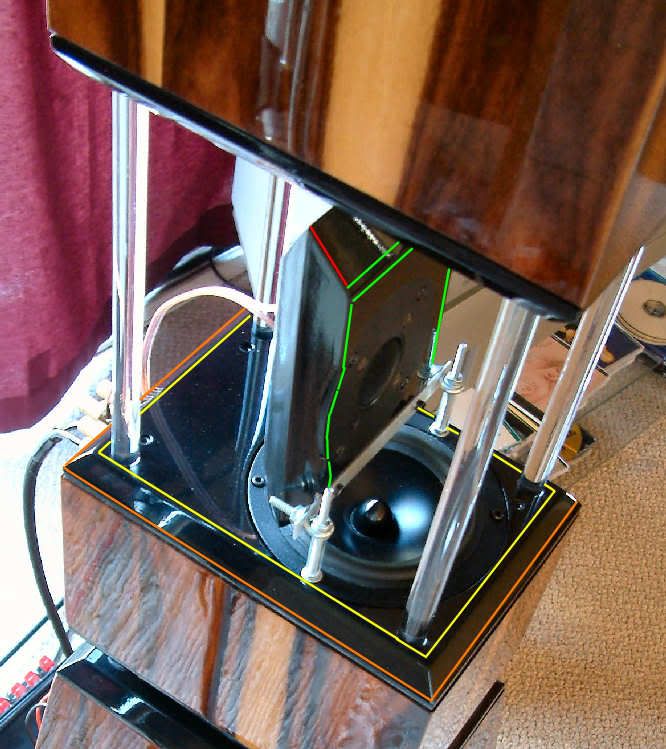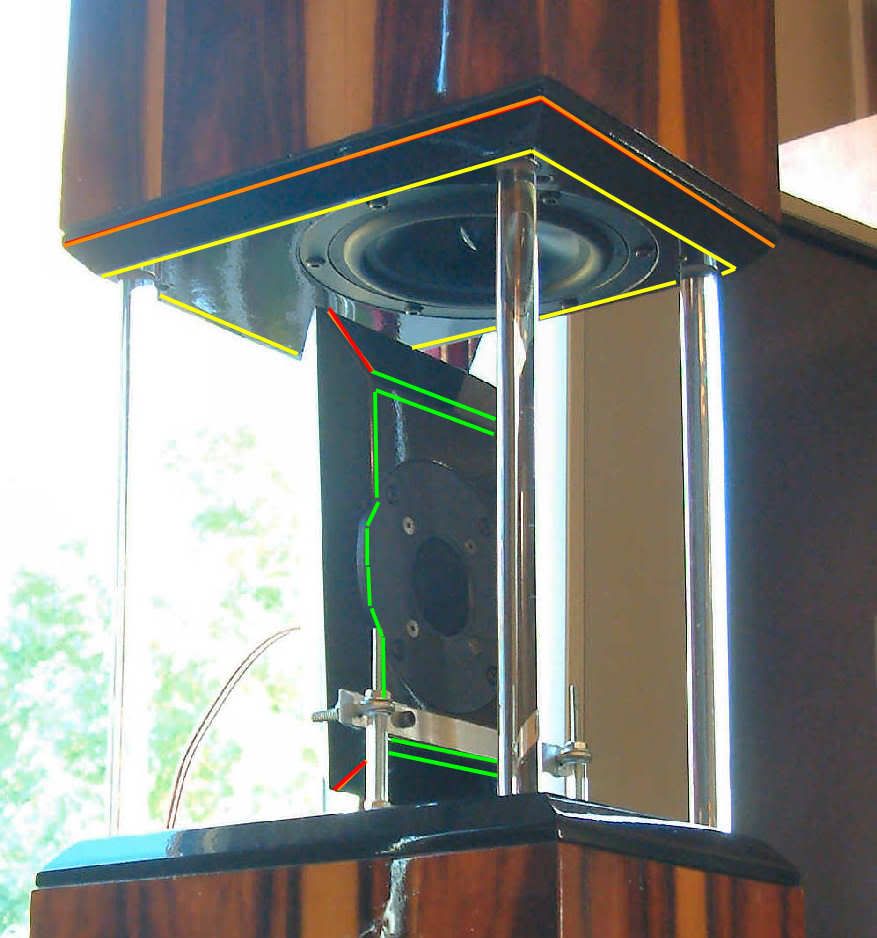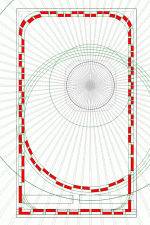dlneubec said:Hey Bud,
I forgot to ask this in the last post. I can't get to the tweeters outside dome due to the metal grid over it, but I can get to the back side of the titanium dome. Is there a benefit to just EnABL'ing the inside of the dome and not the outside?
My Tannoys have a metal grid over the dome but it's only held on by the magnet. It only took me 10 years to realise they were easily removed 😀
See if the grid can rotate or be lifted by a needle through one of the holes, you might be lucky.
BudP said:terry j
Hmmmph, if you think you're worried read, between theses two posts, this thread.
Bud
Bud, I should have added that yes, you have been more than affable whenever someone 'doubts' any results, and that you are more than keen to have any testing done that could uncover what is going on measurement wise, I may not have posted much in this thread but I have been following it all. It is a credit to you. I'm just glad I caught the thread when it started, it is very hard going starting on a thread when it is more than twenty pages long


Got it on the pages, thanks Dave.
I guess old lead ears (me!) should get started ha ha.
Ed,
I am very careful when messing about with those nibs. I do run a fingernail under the various leaves, to help flush out any stringy, half set up paint and will occasionally wiggle the Brass spring tension about to get the tips to realign, after some time spent in the pen tip tin.
Silly to be worried too, because they cost less than a cup of coffee anymore.
Bud
I am very careful when messing about with those nibs. I do run a fingernail under the various leaves, to help flush out any stringy, half set up paint and will occasionally wiggle the Brass spring tension about to get the tips to realign, after some time spent in the pen tip tin.
Silly to be worried too, because they cost less than a cup of coffee anymore.
Bud
forgot to ask what POC means? From later comments I assume it is a microsoft computer or something?
In any case you only need the computer for initial deqx setup, then it is a standalone unit.
however, I suspect a speaker developer and designer such as yourself would NOT set it up once and then leave it ha ha, so if you don't like pc's then yes I guess you are stuck.
In any case you only need the computer for initial deqx setup, then it is a standalone unit.
however, I suspect a speaker developer and designer such as yourself would NOT set it up once and then leave it ha ha, so if you don't like pc's then yes I guess you are stuck.
terry j said:forgot to ask what POC means? From later comments I assume it is a microsoft computer or something?
In any case you only need the computer for initial deqx setup, then it is a standalone unit.
however, I suspect a speaker developer and designer such as yourself would NOT set it up once and then leave it ha ha, so if you don't like pc's then yes I guess you are stuck.
Piece of (insert 4 letter word for number 2).
Yes, i'd be playing with it a lot. And with Apple so far the only ones to ship a piece of Windows software with a decent UI i'd be swearing a blue streak all the time (that isn't from me, but from a buddy that is IT manager in charge of some 500 Windows boxes)...
dave
TerryJ,
Find some really low rez speakers to treat first, please. Just to get your hand and eye coordinated, to cooperating in this sort of tedious play.
Don't know if "CB Radio" was the mass market thrill in your half of the world as it was here. Those really cheap radios had some really really cheap PM speakers in them. If more than one woman and two truckers were talking at once, all communication was forfeit. The awful voices and the horrendous amount of noise were just amazing.
Then I treated the speaker.... could follow all conversations, and the noise was still there. But somehow, it no longer interfered with the information structure of the spoken words. Everything was suddenly very polite.
I knew then that I was in some serious trouble.
Bud
Find some really low rez speakers to treat first, please. Just to get your hand and eye coordinated, to cooperating in this sort of tedious play.
Don't know if "CB Radio" was the mass market thrill in your half of the world as it was here. Those really cheap radios had some really really cheap PM speakers in them. If more than one woman and two truckers were talking at once, all communication was forfeit. The awful voices and the horrendous amount of noise were just amazing.
Then I treated the speaker.... could follow all conversations, and the noise was still there. But somehow, it no longer interfered with the information structure of the spoken words. Everything was suddenly very polite.
I knew then that I was in some serious trouble.
Bud
Dave
thanks for posting a picture in post #836. The drivers especially the "black" with white pattern look stunning, (the whole family agree, even the missis😱 ) they are a miniture Briget Riley masterpiece (Blaze 1). I cant wait to hear them, but in a way after reading all these posts, it almost scary not knowing what they are going to sound like.
thanks for posting a picture in post #836. The drivers especially the "black" with white pattern look stunning, (the whole family agree, even the missis😱 ) they are a miniture Briget Riley masterpiece (Blaze 1). I cant wait to hear them, but in a way after reading all these posts, it almost scary not knowing what they are going to sound like.
marce said:I cant wait to hear them, but in a way after reading all these posts, it almost scary not knowing what they are going to sound like.
If is all is right with the world, they will ruin you for anything else 🙂
And will hopefully spur you to even greater efforts at automation.
I am now putting down the computer and am putting white spots on your phase plugs... pictures tomoroow.
dave
arend-jan said:Cool vids, but what has airflow got to do with it? 😕
I hate opinions but since this process seems (correct me if i'm way out of line) to still not have a full understanding of why it works I brought up air flow. I understand that damping of the standing waves and propagation of the waves into the air are the main process by which this technique appears to work. That said I suspect the modifications are also changing the airflow patterns in the boundry layer just off the face of the cone surface. The other option i've thought of has been touched on and that is that the block pattern could be creating some sort of beneficial diffraction of the sound waves. Maybe Daves "hall of mirrors" is still there but is being redirected so far off axis that it is no longer heard when in most listening positions? Hope this helps offer a little more explaination of what I was getting at. Any thoughts on this concept?
Bud,
Sorry for being so dense, but I'm still having trouble following your description of where to best put the EnABLpatterns on my driver baffles. Attached are two different photos that may make it clearer how these are configured. On the tweeter baffle, the green is where I have put it so far (also on the back side of the top chamfer). I believe you may be telling me to add the red up and over the top chamfer. Is that correct?
Also, I'm wondering about treating the up and down firing mid baffles. Should I do so, and if so, should they be were the yellow line is or where the orange line is?
Thanks for your patience and guidance.


Sorry for being so dense, but I'm still having trouble following your description of where to best put the EnABLpatterns on my driver baffles. Attached are two different photos that may make it clearer how these are configured. On the tweeter baffle, the green is where I have put it so far (also on the back side of the top chamfer). I believe you may be telling me to add the red up and over the top chamfer. Is that correct?
Also, I'm wondering about treating the up and down firing mid baffles. Should I do so, and if so, should they be were the yellow line is or where the orange line is?
Thanks for your patience and guidance.


dlneubec,
On the SEAS H1212, I have found the hexagrid to be held in place by a flexible adhesive. I used a pointed tool and a fulcrum to get it off. Working around the perimeter of the grid...patiently...will remove it.
On the SEAS H1212, I have found the hexagrid to be held in place by a flexible adhesive. I used a pointed tool and a fulcrum to get it off. Working around the perimeter of the grid...patiently...will remove it.
Hi Ed,
Thanks. This one is the Dayton RS28AS-4. I tried a bit of prying, but it did not budge in the slightest.
Thanks. This one is the Dayton RS28AS-4. I tried a bit of prying, but it did not budge in the slightest.
Just out of interest, what would the effect be of an EnABL pattern on NXT technology loudspeakers (panels), and how would you calculate the pattern (If my memory serves me, I think I take the permimiter distance of the loud panel and use this as the circumference).
I am curious as I have a couple of pairs of wharfdale loudpanels that I could play with.
I am curious as I have a couple of pairs of wharfdale loudpanels that I could play with.
marce said:Just out of interest, what would the effect be of an EnABL pattern on NXT technology loudspeakers (panels), and how would you calculate the pattern (If my memory serves me, I think I take the permimiter distance of the loud panel and use this as the circumference).
I am curious as I have a couple of pairs of wharfdale loudpanels that I could play with.
Slightly OT from your question, but I'm curious as to how I would treat a planar, like the BG neo3PDR...without adding too much mass. I assume that they are only "clamped at top and bottom(?).
These kinds of sims would be a useful tool... someone that knows what they are doing would have to set up the sim. Based on my thot experiments i'd expect to see the boundary waves hit the EnABL blocks and then go careening off the cone in a chaotic manner (a rainbow of colours in a pshycodelic fractal-like semi-randomness?)
I wonder if Ron Clarke's tools could handle this?
dave
I wonder if Ron Clarke's tools could handle this?
dave
marce said:Just out of interest, what would the effect be of an EnABL pattern on NXT technology loudspeakers (panels), and how would you calculate the pattern (If my memory serves me, I think I take the permimiter distance of the loud panel and use this as the circumference).
I am curious as I have a couple of pairs of wharfdale loudpanels that I could play with.
An NXT panel would be interesting. Given how they work, it may have little effect, but i'm ready to be surprised.
You would treat the pattern as you would a rectangular box face. Take the perimeter, and use it as a circumference to figure block size and go from there with equal size blocks... or you can get fancy and just use the circular array and 4 inscribed rectangles to generate a more complex pattern. green (or blue) painters masking tape can be used to set the limits of the blocks.
dave
fancy pattern for GR Fonken attached
Attachments
And while i'm at it here is an AutoCad 12 dwg of a basic circular enable pattern... i just scale it to the size of the cone i am EnABLing print that to choose a nib sze, and then print at 90% to get a template to lay down the 1st set of blocks (depending on where you need the template to sit other scaling might be appropriate.
Let me know how well it translates... (there are line weights and line colors and line patterns that the old version of AC might choke on -- i can save as a newer AC if needed.
dave
Let me know how well it translates... (there are line weights and line colors and line patterns that the old version of AC might choke on -- i can save as a newer AC if needed.
dave
Attachments
I guess I could just as easily dial the phone, but I'll ask if any progress yet on EnABL blocks to either GR or clear-coated standard Fonkens?
planet10 said:
Let me know how well it translates... (there are line weights and line colors and line patterns that the old version of AC might choke on -- i can save as a newer AC if needed.
It opens fine, with 2 layers and default line-weights. Thanks for that.🙂
Jeff
- Status
- Not open for further replies.
- Home
- Loudspeakers
- Multi-Way
- EnABL Processes
